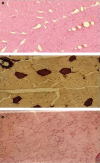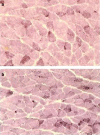Acetazolamide prevents vacuolar myopathy in skeletal muscle of K(+) -depleted rats
- PMID: 18345024
- PMCID: PMC2438991
- DOI: 10.1038/bjp.2008.42
Acetazolamide prevents vacuolar myopathy in skeletal muscle of K(+) -depleted rats
Abstract
Background and purpose: Acetazolamide and dichlorphenamide are carbonic anhydrase (CA) inhibitors effective in the clinical condition of hypokalemic periodic paralysis (hypoPP). Whether these drugs prevent vacuolar myopathy, which is a pathogenic factor in hypoPP, is unknown. The effects of these drugs on the efflux of lactate from skeletal muscle were also investigated.
Experimental approach: For 10 days, K(+)-depleted rats, a model of hypoPP, were administered 5.6 mg kg(-1) day(-1) of acetazolamide, dichlorphenamide or bendroflumethiazide (the last is not an inhibitor of CA). Histological analysis of vacuolar myopathy and in vitro lactate efflux measurements were performed in skeletal muscles from treated and untreated K(+)-depleted rats, and also from normokalemic rats.
Key results: About three times as many vacuoles were found in the type II fibres of tibialis anterioris muscle sections from K(+)-depleted rats as were found in the same muscle from normokalemic rats. In ex vivo experiments, a higher efflux of lactate on in vitro incubation was found in muscles of K(+)-depleted rats compared with that found in muscles from normokalemic rats. After treatment of K(+)-depleted rats with acetazolamide, the numbers of vacuoles in tibialis anterioris muscle decreased to near normal values. Incubation with acetazolamide in vitro inhibited efflux of lactate from muscles of K(+)-depleted rats. In contrast, bendroflumethiazide and dichlorphenamide failed to prevent vacuolar myopathy after treatment in vivo and failed to inhibit lactate efflux in vitro.
Conclusions and implications: Acetazolamide prevents vacuolar myopathy in K(+)-depleted rats. This effect was associated with inhibition of lactate transport, rather than inhibition of CA.
Figures




Similar articles
-
Carbonic anhydrase inhibitors are specific openers of skeletal muscle BK channel of K+-deficient rats.FASEB J. 2004 Apr;18(6):760-1. doi: 10.1096/fj.03-0722fje. Epub 2004 Feb 6. FASEB J. 2004. PMID: 14766795
-
Extracellular carbonic anhydrase activity facilitates lactic acid transport in rat skeletal muscle fibres.J Physiol. 2001 Mar 15;531(Pt 3):743-56. doi: 10.1111/j.1469-7793.2001.0743h.x. J Physiol. 2001. PMID: 11251055 Free PMC article.
-
Carbonic anhydrase inhibitors ameliorate the symptoms of hypokalaemic periodic paralysis in rats by opening the muscular Ca2+-activated-K+ channels.Neuromuscul Disord. 2006 Jan;16(1):39-45. doi: 10.1016/j.nmd.2005.10.005. Epub 2005 Dec 20. Neuromuscul Disord. 2006. PMID: 16368240
-
Increased sarcolemma chloride conductance as one of the mechanisms of action of carbonic anhydrase inhibitors in muscle excitability disorders.Exp Neurol. 2021 Aug;342:113758. doi: 10.1016/j.expneurol.2021.113758. Epub 2021 May 12. Exp Neurol. 2021. PMID: 33991525
-
Effect of bendroflumethiazide on distal nephron transport of sodium, potassium and chloride.J Pharmacol Exp Ther. 1966 Feb;151(2):168-79. J Pharmacol Exp Ther. 1966. PMID: 5932595 No abstract available.
Cited by
-
Oxytocin/Osteocalcin/IL-6 and NGF/BDNF mRNA Levels in Response to Cold Stress Challenge in Mice: Possible Oxytonic Brain-Bone-Muscle-Interaction.Front Physiol. 2019 Nov 27;10:1437. doi: 10.3389/fphys.2019.01437. eCollection 2019. Front Physiol. 2019. PMID: 31827442 Free PMC article.
-
Zoledronic Acid Blocks Overactive Kir6.1/SUR2-Dependent KATP Channels in Skeletal Muscle and Osteoblasts in a Murine Model of Cantú Syndrome.Cells. 2023 Mar 17;12(6):928. doi: 10.3390/cells12060928. Cells. 2023. PMID: 36980269 Free PMC article.
-
Molecular Composition and Biological Activity of a Novel Acetonitrile-Water Extract of Lens Culinaris Medik in Murine Native Cells and Cell Lines Exposed to Different Chemotherapeutics Using Mass Spectrometry.Cells. 2023 Feb 10;12(4):575. doi: 10.3390/cells12040575. Cells. 2023. PMID: 36831242 Free PMC article.
-
K+-dependent paradoxical membrane depolarization and Na+ overload, major and reversible contributors to weakness by ion channel leaks.Proc Natl Acad Sci U S A. 2009 Mar 10;106(10):4036-41. doi: 10.1073/pnas.0811277106. Epub 2009 Feb 18. Proc Natl Acad Sci U S A. 2009. PMID: 19225109 Free PMC article.
-
Pharmacovigilance database search discloses ClC-K channels as a novel target of the AT1 receptor blockers valsartan and olmesartan.Br J Pharmacol. 2017 Jul;174(13):1972-1983. doi: 10.1111/bph.13794. Epub 2017 Apr 26. Br J Pharmacol. 2017. PMID: 28334417 Free PMC article.
References
-
- Al-Aloul B, Li JM, Benditt D, Tholakanahalli V. Atrial fibrillation associated with hypokalemia due to primary hyperaldosteronism (Conn's syndrome) Pacing Clin Electrophysiol. 2006;29:1303–1305. - PubMed
-
- Banker BQ, Engel AG.Basic reactions of muscle Myology 2004McGraw-Hill Press: USA; 691–748.In: Engel AG, Franzini-Armstrong C (eds).3rd edn. Vol. 30
-
- Ciszowski K, Winnik L, Groszek B, Klys M, Kolodziej J. Acute chloroquine intoxication—rare, but always serious: case reports and literature review. Przegl Lek. 2005;62:501–507. - PubMed
-
- Clare BW, Supuran CT. A perspective on quantitative structure–activity relationships and carbonic anhydrase inhibitors. Expert Opin Drug Metab Toxicol. 2006;2:113–137. - PubMed
Publication types
MeSH terms
Substances
LinkOut - more resources
Full Text Sources
Medical

